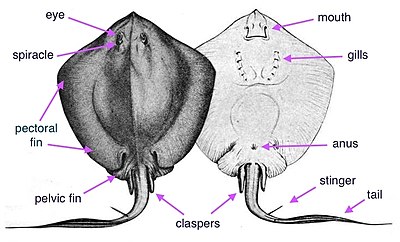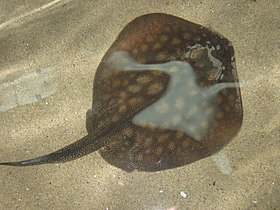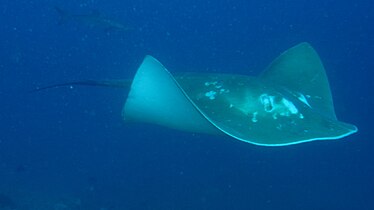Stingray
| Stingrays Temporal range:
| |
|---|---|

| |
| Southern stingray (Hypanus americanus) | |
| Scientific classification | |
| Domain: | Eukaryota |
| Kingdom: | Animalia |
| Phylum: | Chordata |
| Class: | Chondrichthyes |
| Subclass: | Elasmobranchii |
| Superorder: | Batoidea |
| Order: | Myliobatiformes |
| Suborder: | Myliobatoidei Compagno , 1973
|
| Families | |
| |
Stingrays are a group of sea
There are about 220 known stingray species organized into 29 genera.Stingrays are common in coastal
Stingray species are
Evolution
Stingrays diverged from their closest relatives, the panrays, during the Late Jurassic period, and diversified over the course of the Cretaceous into the different extant families today. The earliest stingrays appear to have been benthic, with the ancestors of the eagle rays becoming pelagic during the early Late Cretaceous.[7][8]
Fossils

Full-body stingray fossils are very rare but are known from certain lagerstätte that preserve soft-bodied animals. The extinct Cyclobatis of the Cretaceous of Lebanon is thought to be a skate that had convergently evolved a highly stingray-like body plan, although its exact taxonomic placement is still uncertain.[10] True stingray fossils become more common in the Eocene, with the extinct freshwater stingrays Heliobatis and Asterotrygon known from the Green River Formation.[11] A diversity of stingray fossils is known from the Eocene Monte Bolca formation from Italy, including the early stingaree Arechia, as well as Dasyomyliobatis, which is thought to represent a transitional form between stingrays and eagle rays, and the highly unusual Lessiniabatis, which had an extremely short and slender tail with no sting.[7][8]
Anatomy

External anatomy of a male bluntnose stingray (Hypanus say)
Jaw and teeth
The mouth of the stingray is located on the
Spiracles
Spiracles are small openings that allow some fish and amphibians to breathe. Stingray spiracles are openings just behind its eyes. The respiratory system of stingrays is complicated by having two separate ways to take in water to use the oxygen. Most of the time stingrays take in water using their mouth and then send the water through the gills for gas exchange. This is efficient, but the mouth cannot be used when hunting because the stingrays bury themselves in the ocean sediment and wait for prey to swim by.[16] So the stingray switches to using its spiracles. With the spiracles, they can draw water free from sediment directly into their gills for gas exchange.[17] These alternate ventilation organs are less efficient than the mouth, since spiracles are unable to pull the same volume of water. However, it is enough when the stingray is quietly waiting to ambush its prey.
The flattened bodies of stingrays allow them to effectively conceal themselves in their environments. Stingrays do this by agitating the sand and hiding beneath it. Because their eyes are on top of their bodies and their mouths on the undersides, stingrays cannot see their prey after capture; instead, they use smell and electroreceptors (ampullae of Lorenzini) similar to those of sharks.[18] Stingrays settle on the bottom while feeding, often leaving only their eyes and tails visible. Coral reefs are favorite feeding grounds and are usually shared with sharks during high tide.[19]
Behavior

Reproduction

During the
Reproductive ray behaviors are associated with their behavioral endocrinology, for example, in species such as the atlantic stingray (Hypanus sabinus), social groups are formed first, then the sexes display complex courtship behaviors that end in pair copulation which is similar to the species Urobatis halleri.[22] Furthermore, their mating period is one of the longest recorded in elasmobranch fish. Individuals are known to mate for seven months before the females ovulate in March. During this time, the male stingrays experience increased levels of androgen hormones which has been linked to its prolonged mating periods.[22] The behavior expressed among males and females during specific parts of this period involves aggressive social interactions.[22] Frequently, the males trail females with their snout near the female vent then proceed to bite the female on her fins and her body.[22] Although this mating behavior is similar to the species Urobatis halleri, differences can be seen in the particular actions of Hypanus sabinus. Seasonal elevated levels of serum androgens coincide with the expressed aggressive behavior, which led to the proposal that androgen steroids start, indorse and maintain aggressive sexual behaviors in the male rays for this species which drives the prolonged mating season. Similarly, concise elevations of serum androgens in females has been connected to increased aggression and improvement in mate choice. When their androgen steroid levels are elevated, they are able to improve their mate choice by quickly fleeing from tenacious males when undergoing ovulation succeeding impregnation. This ability affects the paternity of their offspring by refusing less qualified mates.[22]
Stingrays are
At the Sea Life London Aquarium, two female stingrays delivered seven baby stingrays, although the mothers have not been near a male for two years. This suggests some species of rays can store sperm then give birth when they deem conditions to be suitable.[25]
Locomotion

The stingray uses its paired
Feeding behavior and diet

Stingrays use a wide range of feeding strategies. Some have specialized jaws that allow them to crush hard mollusk shells,
Most stingrays feed primarily on mollusks, crustaceans and, occasionally, on small fish. Freshwater stingrays in the Amazon feed on insects and break down their tough exoskeletons with mammal-like chewing motions.[34] Large pelagic rays like the manta use ram feeding to consume vast quantities of plankton and have been seen swimming in acrobatic patterns through plankton patches.[35]
Stingray injuries

Stingrays are not usually aggressive and ordinarily attack humans only when provoked, such as when they are accidentally stepped on.[36] Stingrays can have one, two or three blades. Contact with the spinal blade or blades causes local trauma (from the cut itself), pain, swelling, muscle cramps from the venom and, later, may result in infection from bacteria or fungi.[37] The injury is very painful, but rarely life-threatening unless the stinger pierces a vital area.[36] The blade is often deeply barbed and usually breaks off in the wound. Surgery may be required to remove the fragments.[38]
Fatal stings are very rare.[36] The death of Steve Irwin in 2006 was only the second recorded in Australian waters since 1945.[39] The stinger penetrated his thoracic wall and pierced his heart, causing massive trauma and bleeding.[40]
Venom

The venom of the stingray has been relatively unstudied due to the mixture of venomous tissue secretions cells and mucous membrane cell products that occurs upon secretion from the spinal blade. The spine is covered with the epidermal skin layer. During secretion, the venom penetrates the epidermis and mixes with the mucus to release the venom on its victim. Typically, other venomous organisms create and store their venom in a gland. The stingray is notable in that it stores its venom within tissue cells. The toxins that have been confirmed to be within the venom are cystatins, peroxiredoxin and galectin.[41] Galectin induces cell death in its victims and cystatins inhibit defense enzymes. In humans, these toxins lead to increased blood flow in the superficial capillaries and cell death.[42] Despite the number of cells and toxins that are within the stingray, there is little relative energy required to produce and store the venom.
The venom is produced and stored in the secretory cells of the vertebral column at the mid-distal region. These secretory cells are housed within the ventrolateral grooves of the spine. The cells of both marine and freshwater stingrays are round and contain a great amount of granule-filled cytoplasm.[43] The stinging cells of marine stingrays are located only within these lateral grooves of the stinger.[44] The stinging cells of freshwater stingray branch out beyond the lateral grooves to cover a larger surface area along the entire blade. Due to this large area and an increased number of proteins within the cells, the venom of freshwater stingrays has a greater toxicity than that of marine stingrays.[43]
Human use
As food

Rays are edible, and may be caught as food using fishing lines or spears. Stingray recipes can be found in many coastal areas worldwide.[45] For example, in Malaysia and Singapore, stingray is commonly grilled over charcoal, then served with spicy sambal sauce. In Goa, and other Indian states, it is sometimes used as part of spicy curries. Generally, the most prized parts of the stingray are the wings, the "cheek" (the area surrounding the eyes), and the liver. The rest of the ray is considered too rubbery to have any culinary uses.[46]
Ecotourism
Stingrays are usually very docile and curious, their usual reaction being to flee any disturbance, but they sometimes brush their fins past any new object they encounter. Nevertheless, certain larger species may be more aggressive and should be approached with caution, as the stingray's defensive reflex (use of its venomous stinger) may result in serious injury or death.[47]
Other uses

The skin of the ray is used as an under layer for the cord or leather wrap (known as samegawa in
Several ethnological sections in museums,[49] such as the British Museum, display arrowheads and spearheads made of stingray stingers, used in Micronesia and elsewhere.[50] Henry de Monfreid stated in his books that before World War II, in the Horn of Africa, whips were made from the tails of big stingrays and these devices inflicted cruel cuts, so in Aden, the British forbade their use on women and slaves. In former Spanish colonies, a stingray is called raya látigo ("whip ray").
Some stingray species are commonly seen in public aquarium exhibits and more recently in home aquaria.[45][51]
Gallery
-
Unlike othergill slits.
-
Deepwater stingrays (Plesiobatis daviesi) are found on the upper continental slope throughout the Indo-Pacific.
-
Spotted stingarees (Urolophus gigas) are found along the Western Australian coast.
-
Western Americancoast.
-
Leopard whiprays (Himantura leoparda) are vulnerable from overfishing.
-
freshwater environments along the Southeastern United Statescoast.
-
The smalleye stingray (Megatrygon microps) is a rare stingray distributed throughout the Indo-Pacific.
-
Theopen ocean.
-
Bluespotted ribbontail rays (Taeniura lymma) are near threatened.
-
Giant freshwater stingrays (Urogymnus polylepis) are the largest freshwater fish.
-
South Americanrivers.
-
South Americancoast.
-
Giant oceanic manta rays (Mobula birostris) are the largest of the stingrays.
-
Golden cownose rays (Rhinoptera steindachneri) often migrate in large schools.
See also
References
- S2CID 86179086.
- ISBN 978-0-471-25031-9.
- ISBN 978-0-86542-256-8.
- ^ Bester C, Mollett HF, Bourdon J (2017-05-09). "Pelagic Stingray". Florida Museum of Natural History, Ichthyology department. Archived from the original on 2016-01-15. Retrieved 2009-09-29.
- ^ The Future of Sharks: A Review of Action and Inaction Archived 2013-05-12 at the Wayback Machine CITES AC25 Inf. 6, 2011.
- ^ "IUCN Red List". International Union for Conservation of Nature. Archived from the original on June 27, 2014.
- ^ PMID 31575915.
- ^ PMID 37533696.
- ^ "Heliobatis radians Stingray Fossil from Green River". www.fossilmall.com. Retrieved 2023-02-14.
- PMID 31156351.
- S2CID 83986811.
- ISBN 9781439839263. Archivedfrom the original on 2022-01-10. Retrieved 2020-11-21.
- ISBN 9788171419081. Archivedfrom the original on 2022-01-10. Retrieved 2020-11-21.
- PMID 26567348.
- PMID 9320215.
- ^ "Stingray". bioweb.uwlax.edu. Archived from the original on 2018-07-23. Retrieved 2018-05-12.
- ISBN 978-0-07-802302-6.
- PMID 24290363.
- ^ Heller, Jason (14 April 2009). "Stingray City - Altering Stingray Behavior & Physiology?". DivePhotoGuide. Retrieved 2023-02-14.
- S2CID 42318841.
- ^ FAQs on Freshwater Stingray Behavior Archived 2017-10-02 at the Wayback Machine. Wetwebmedia.com. Retrieved on 2012-07-17.
- ^ S2CID 11150958.
- ^ Florida Museum of Natural History Ichthyology Department: Atlantic Stingray Archived 2016-01-04 at the Wayback Machine. Flmnh.ufl.edu. Retrieved on 2012-07-17.
- ^ Seubert, Curtis (April 24, 2017). "How Do Stingrays Take Care of Their Young?". Sciencing. Archived from the original on December 16, 2018. Retrieved December 14, 2018.
- ^ "Stingrays born in female only tank". The Sydney Morning Herald. 2011-08-10. Archived from the original on 2020-07-25. Retrieved 2020-07-25.
- S2CID 136537698.
- PMID 23477972.
- ^ .
- S2CID 124395779. Archived from the original(PDF) on 2020-02-15.
- PMID 26183820.
- PMID 21672821.
- S2CID 8090692.
- PMID 22244456.
- PMID 27629029.
- JSTOR 1445487.
- ^ PMID 19319171. Archived from the originalon April 17, 2011.
- ^ "Stingray Injury Case Reports". Clinical Toxicology Resources. University of Adelaide. Archived from the original on 4 April 2019. Retrieved 22 October 2012.
- PMID 10340692.
- ^ Hadhazy, Adam T. (2006-09-11). "I thought stingrays were harmless, so how did one manage to kill the "Crocodile Hunter?"". Scienceline. Archived from the original on 2022-03-29. Retrieved 2018-11-18.
- ^ Discovery Channel Mourns the Death of Steve Irwin Archived 2013-01-07 at the Wayback Machine. animal.discovery.com
- PMID 26094699.
- PMID 28801624.
- ^ PMID 17659760.
- .
- ^ a b "Animal Diversity Web – Dasyatidae, Stingrays". Animal Diversity Web. 2021-03-10. Archived from the original on 2021-06-17. Retrieved 2021-03-10.
- ^ Lin, Eddie (2006). "The Delicious and Deadly Stingray. Nyonya. New York, NY. (Partially from the Archives.)". Deep End Dining. (blog). Retrieved 2023-02-14.
- ^ Sullivan BN (May 2009). "Stingrays: Dangerous or Not?". The Right Blue. Archived from the original on 24 July 2012. Retrieved 17 July 2012.
- ^ "The Samegawa – Parts of a Japanese Katana". Reliks. Archived from the original on 2021-02-26. Retrieved 2021-03-10.
- ^ FLMNH Ichthyology Department: Daisy Stingray Archived 2016-01-04 at the Wayback Machine. Flmnh.ufl.edu. Retrieved on 17 July 2012.
- ^ Dasyatis rudis (Smalltooth Stingray). Iucnredlist.org. Retrieved on 17 July 2012.
- ^ Michael, Scott W. (September 2014). "Rays in the Home Aquarium". Tropical Fish Magazine. Archived from the original on 2021-04-22. Retrieved 2021-03-10.
Bibliography
- Froese, Rainer, and Daniel Pauly, eds. (2005). "Dasyatidae" in FishBase. August 2005 version.
External links
- "Beware the Ugly Sting Ray." Popular Science, July 1954, pp. 117–118/pp. 224–228.















